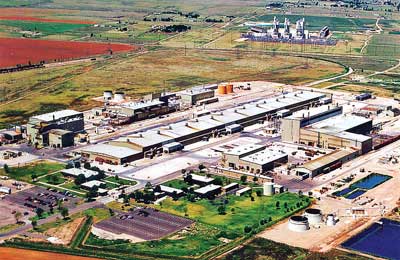 |
| ASARCO’s Amarillo copper refinery complex includes an anode department, tankhouse, refined casting departments, a copper scrap facility, nickel plant and support facilities. |
ASARCO’s copper refinery in Amarillo, Texas, is capable of refining nearly 500,000 tons of copper anode and scrap each year.
Built in 1974, the refinery installed its electrolyte purification facility in 1993 to improve the quality of the refining process. Twenty years later, the purification system was in need of an upgrade.
Challenge
The ASARCO refinery houses 2,400 cells to carry out conventional electrowinning in which thin, pure copper cathode sheets are suspended in tanks filled with electrolyte solution and the anodes are inserted. When the anodes are charged with electric current, their copper atoms plate the cathode sheets. After 14 days, the cathodes reach a salable weight and are removed. A new cathode sheet is inserted and the process begins anew.
“The primary outcome of the process is the pure copper cathode,” said Jim Williams, project manager, ASARCO. “But there are also byproducts—small quantities of other metals and minerals—that vary depending on the composition of the ore body.”
Byproducts either drop to the bottom of the electrowinning cell or are dissolved into the electrolyte solution. These elements are recovered and processed for sale.
“Marketplace value aside, we must also recover the soluble elements to maintain the quality of our electrolyte solution,” Williams explained. “This costly solution is continuously reused via a closed-loop system.”
In recent years, the plant feed’s bismuth content—an element that’s soluble in the electrolyte liquid—has become significant enough to warrant recovery.
A complex eight-phase process was put in place to recover the bismuth. To maintain the quality of the electrolyte solution, the recovery system is temperature controlled and the bismuth concentration level is monitored to determine when to begin the purification process.
ASARCO configured the plant’s original distributed control system (DCS) to run the recovery process. However, the company soon became aware of the limitations of the 20-year-old equipment.
“The DCS was a conglomeration of three different control platforms,” said Williams. “Since there was extensive hard-wire interface throughout, it was difficult to troubleshoot. Downtime became an issue.”
Due to serial communication, the overall system response time was sluggish. And since the system was not fully automated, manual intervention was required to start and stop each process sequence.
“The predictability and repeatability of the system was an issue,” Williams said. “Determining exactly when to begin the purification process was a bit ‘hit or miss.’ Missing the purification ‘window’ could compromise the electrolyte solution.”
In addition, maintaining the system was difficult. Components were becoming obsolete and replacement parts were increasingly difficult to find.
 |
| A new control room allows operators to understand what’s happening in real time, and take immediate action to optimize system performance. |
Solution
ASARCO called on Prime Controls, a Rockwell Automation Solution Partner, to design the new purification control system. Based in Lewisville, Texas, Prime Controls is a systems integration and Instrument and Controls (I&C) construction firm with expertise in heavy industry applications.
“Our goal was to design a control solution on a single platform that could handle every phase of the bismuth recovery process,” said Trinidad Cruz, regional manager, Prime Controls.
To replace the existing DCS system, Prime Controls designed and installed a PlantPAx process automation system from Rockwell Automation.
This new system includes an information-enabled, scalable, multidiscipline control platform that combines process and discrete control with communication and state-of-the-art I/O. The system includes 300 I/O points and runs on a fiber optic Ethernet/IP network.
“The PlantPAx system handles the loading phase at the beginning of the purification process, as well as each batch sequence,” Cruz said. “And the fiber optic network helps ensure the response times required throughout the process.”
In addition, the PlantPAx system includes supervisory-level visualization capabilities to provide operators with optimal insight into process information—from the comfort of their newly designed control room.
“With the new solution in place, our operators can immediately see the results of the electrolyte chemical analysis,” Williams said. “Now, the purification process can be selected to begin at the exact critical time.”
Prime Controls also designed the system for future migrations. While this project focused on the purification process, ASARCO hopes to integrate their rectifier and circulation systems—and additional software capabilities—at a later date.
Results
“When we started this upgrade project, our objective was to lower operating costs, improve efficiency and decrease our downtime,” said Williams. “The bismuth recovery solution delivered on all three points.”
Williams attributes much of the solution’s success to replacing the multiple systems with one integrated system.
“Simply put, we no longer have to maintain multiple systems,” Williams said. “And the fiber optic network is a vast improvement over serial communication.”
Thanks to improved visualization, the predictability—and repeatability—of the system is greatly enhanced. Operators see exactly what is occurring and execute decisions based on the information.
Although the company is still gathering data, preliminary results indicate the PlantPAx system could reduce bismuth recovery overhead costs.
“Solution delivery played a major role in our overall success,” Williams said. “Prime Controls’ professionalism and attention to detail is phenomenal. From system design through execution, they don’t leave anything to chance.”
Looking toward the future, Williams cited the flexibility of the system as another key benefit. ASARCO already has the hardware in place to extend system visibility to the enterprise level when the company is ready to do so.
“The real beauty of the system is its flexibility,” said Williams. “With Rockwell Automation solutions, you know any capabilities you add will fold right into this same integration plan. You can just keep building, knowing everything is going to work together.”
The preceding article was provided for publication in E&MJ by Rockwell Automation, which cautions that the results presented in the article are specific to ASARCO’s use of Rockwell Automation products and services in conjunction with other products. Specific results may vary for other customers.









